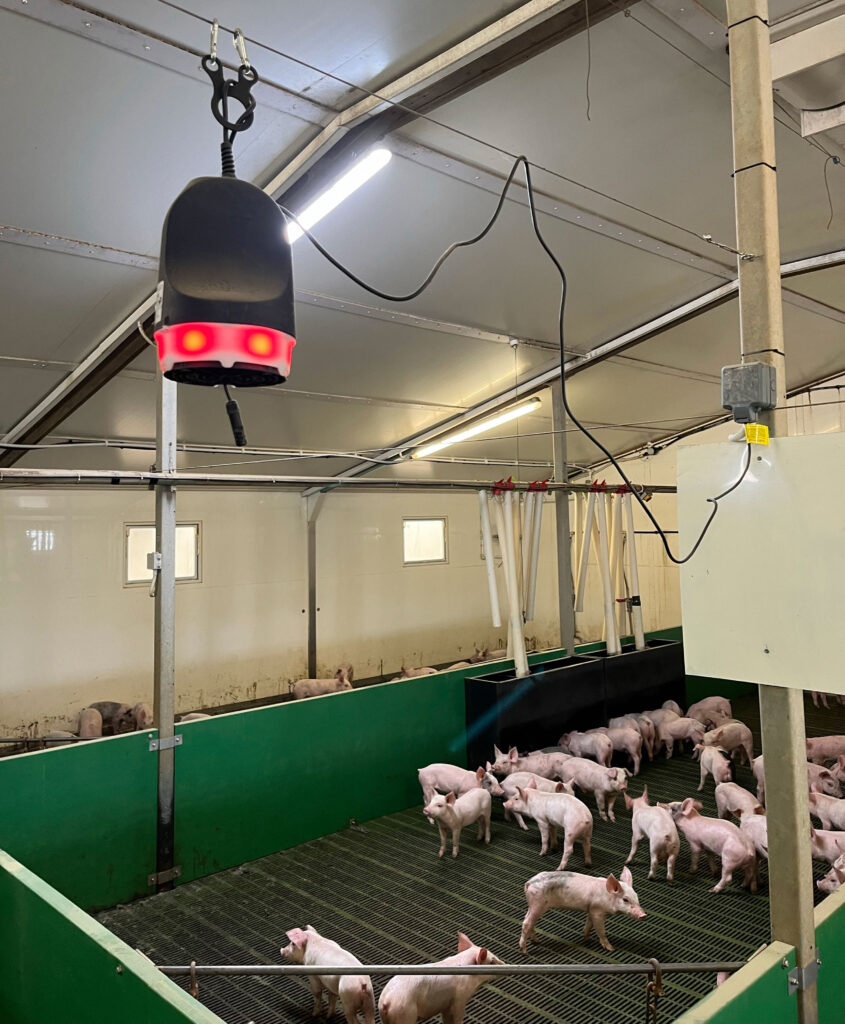Pig tech promises 5-day advantage detecting coughs

© Boerhinger Ingelheim
A listening device that monitors coughing in pigs can alert the producer to the onset of respiratory disease up to five days earlier than farm personnel.
SoundTalks, launched across the UK and Ireland by Boehringer Ingelheim, uses artificial intelligence algorithms to “listen” to the frequency and intensity of coughs in pigs.
While sound analytics is not new, the company says the algorithms to compare and detect coughs in this device are based on years of data, and the system is continually “learning”.
With 24/7 monitoring, the device provides pig farmers with a reliable and objective way to detect trends in respiratory conditions using real-time data.
How it works
Each SoundTalks covers up to a 10m radius in housing and in addition to a microphone, it has humidity and temperature sensors.
The monitors transmit pig noises to the gateway, which links to the cloud where sounds are analysed.
Sound data is then translated into a respiratory health score, which is inversely related to the risk of morbidity and mortality.
This is then visualised via an online dashboard and mobile app.
The monitors themselves also signal the respiratory health status of the pigs, flagging up anomalies with a traffic-light system, which helps farmers identify and focus attention on the right groups of pigs sooner.
In European trials, involving some 1,655 pigs aged 11 weeks, use of the technology resulted in an increase of 12.7g average daily gain as well as lower mortality rates.
English weaners
One pig manager who is now trialling SoundTalks in England is Louise Garrod, who looks after 4,000 weaners in four slatted sheds.
The Duroc pigs are on a B&B system from five weeks to eight to10 weeks, when they are sent on at 35-50kg to be finished at 120kg on a second unit.
“We have had two monitors in each shed, since 16 February, and the gateway is in the store room where it connects to the internet.
“We had to install electric sockets and a stainless stell wire for the monitors to hang 2m above the pigs,” she explains.
Once plugged in and connected, the monitors took about a day to self-calibrate, she adds.
“The monitors show green, amber or red lights according to the percentage of healthy pigs.
“A green light is 60-100% healthy pigs; amber at 40-60% when you might hear a bit of coughing, or occasionally a distressed pig squealing.
“A red light shows when below 40% are healthy – at this stage, you need to speak to a vet as there is clearly something wrong.”
While Louise normally checks each monitor’s colour first thing every morning, she also uses the phone app.
This is able to show the actual percentage of healthy pigs, rather than a range. “For instance, the monitor light is still green whether it’s 60% or 80%,” she adds.
Identifying gut issues
So far, Louise has used the system with two batches of pigs.
She found it useful with her second batch as the monitor turned amber without any visible signs of illness in the pigs.
Further investigation discovered a problem with the water system, which ultimately led to some gut issues.
“Despite their setbacks, they developed well and we used less antibiotics in treatment,” she says.
“We aren’t in the sheds 24 hours a day and humans are not infallible, so the monitors are an added measure to tell you something is wrong.”
Louise thinks the system is “very good and helps make sure you don’t miss problems”, however, she points out that its benefit is through supporting the other data she monitors.
This ranges from water and feed intakes to ventilation in the housing.
Technology needs to be used in conjunction with other recording, she says, not treated as a replacement for good stockmanship.
SoundTalks is being used in Europe and is now available in the UK and Ireland.
Pricing information
The hardware is £472.50 for a gateway or monitor, depending on shed layout and farm size, the system comprises at least one gateway and multiple monitors.
Each gateway can receive information from up to about 14-16 monitors, equivalent to 300-500 pigs a batch, depending on age.
To access the data and platform, each monitor has an annual subscription fee of £160.
A farm monitoring 11,000 piglets a year, for instance, using one gateway and four monitors, would pay 27p a piglet in the first year (hardware plus subscription) then 6p a piglet thereafter as a subscription fee.
More research can be found on the SoundTalks website.

